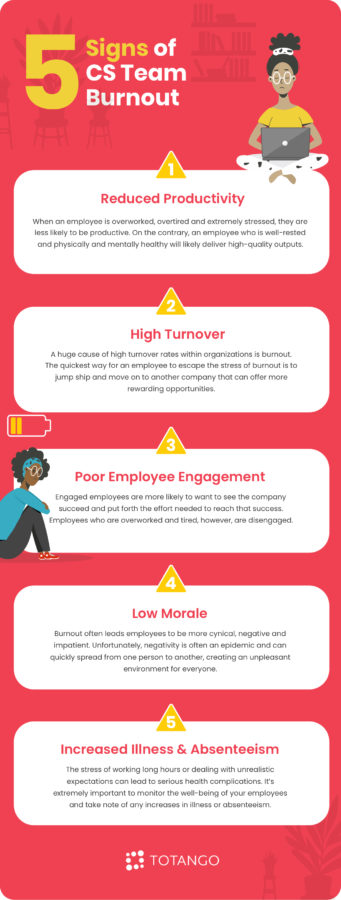In a recent poll, we asked customer success professionals to rank their top year-end challenge. Not surprisingly, the number one answer was burnout.
Burnout is a common occurrence, especially at the end of the year and especially in customer-facing industries like CS. But add to that a lingering global pandemic and crushing labor and supply shortages, and you’ve got a recipe for disaster.
With the constant pressures of increasing workloads, longer working hours and figuring out how to strike a proper work-life balance, burnout is on the rise like never before. To help you and your team combat this dangerous phenomenon, we’re going to do a series of articles over the next few weeks discussing various burnout and mental health topics. In this article, we’ll take a look at what burnout really is, the impact it can have on your organization and what burnout signs you should be on the lookout for within your team.
What is Burnout?
In the past, burnout and other work-related mental health issues were dismissed by organizations as personal problems that could be easily solved by working a few fewer hours each week or switching to a new role. However, in recent years, the physical, emotional, and financial burdens associated with burnout have come to light, causing a newfound understanding and respect for the importance of recognizing and preventing burnout.
 In fact, employee burnout has become so severe that in 2019 the World Health Organization (WHO) officially recognized it as a medical condition defined as a “syndrome conceptualized as resulting from chronic workplace stress that has not been successfully managed.” According to WHO, burnout is characterized by feelings of exhaustion, increased mental distance or feelings of negativity related to your job, and reduced professional efficiency.
In fact, employee burnout has become so severe that in 2019 the World Health Organization (WHO) officially recognized it as a medical condition defined as a “syndrome conceptualized as resulting from chronic workplace stress that has not been successfully managed.” According to WHO, burnout is characterized by feelings of exhaustion, increased mental distance or feelings of negativity related to your job, and reduced professional efficiency.
Burnout can no longer be written off as a personal issue; it is a serious challenge that needs to be handled on an organizational level. In addition to the physical, mental and emotional risks burnout places on individuals, it can also have severe impacts on organizations. When employees are burned out, they are less motivated to perform and more likely to leave. Decreased productivity, a high turnover rate, low engagement, and employees with poor mental and physical health all lead to heavy financial burdens for companies.
It’s important to be able to spot the signs of burnout and intercept any issues before they affect your employees or your organization. Here are five signs of burnout to be on the lookout for in your organization.
Five Signs of Employee Burnout
Reduced Productivity
Are your employees struggling to concentrate? Are they missing deadlines or making careless mistakes? While these factors could certainly be attributed to a personal issue, they are often associated with burnout. When an employee is overworked, overtired and extremely stressed, they are less likely to be productive. On the contrary, an employee who is well-rested and physically and mentally healthy will likely deliver high-quality outputs.
High Turnover
A huge cause of high turnover rates within organizations is burnout. The quickest way for an employee to escape the stress of burnout is to jump ship and move on to another company that can offer more rewarding opportunities. Turnover comes with an extremely high price for companies, however. A study by the Center for American Progress found that organizations spend anywhere from 16 to 213% of an employee’s salary to cover the cost of replacing them. Not to mention the cost of losing valuable, high-performing employees due to burnout. So, if you begin to notice an uptick in your company’s turnover rate, it’s important to investigate whether or not your employees are dealing with burnout before it becomes a bigger problem.
Poor Employee Engagement
Are your employees motivated to work hard? Are they excited about your company’s goals and contributing to the overall growth and success of the organization? Engaged employees are more likely to want to see the company succeed and put forth the effort needed to reach that success. Employees who are overworked and tired, however, are disengaged. They don’t feel connected to the organization or its goals, and therefore, don’t feel the need to work hard or be productive. A disengaged workforce who is just showing up for the paycheck can stagnate the growth and success of a company.
Low Morale
Burnout often leads employees to be more cynical, negative and impatient. They can be short with one another and even with customers. Unfortunately, negativity is often an epidemic and can quickly spread from one person to another, creating an unpleasant environment for everyone. If you notice your employees frequently complaining or getting into conflicts with one another, you may have a burnout problem.
Increased Illness & Absenteeism
One of the greatest impacts of burnout is the mental and physical toll it takes on individuals. The stress of working long hours or dealing with unrealistic expectations can lead to serious health complications. An overworked employee is less likely to get adequate sleep and exercise and is more likely to develop unhealthy behavior patterns like overeating and binge drinking to cope with the stress. If an employee is not taking care of themselves, they are also more likely to get sick, so they will have to take more sick days which creates an added burden on other employees who have to fill in for them. It’s extremely important to monitor the well-being of your employees and take note of any increases in illness or absenteeism.
Dealing with Burnout
If you notice any or all of the above signs of burnout, it’s critical to take action immediately to try and alleviate your employee’s symptoms. We will discuss more tips for fighting burnout and dealing with workplace stress in future articles, but a few quick things you can do are:
- Reevaluate deadlines and adjust as necessary to make them more manageable
- Make sure your leadership team is openly communicating with and supporting employees
- Promote a positive work environment by encouraging collaboration and showing appreciation for employees and their hard work
- If possible, offer more flexible work hours or work-from-home options
- Encourage healthy habits by providing nutritious food on-site, gym memberships or access to mental health workshops or counseling
Finally, Totango is here to help alleviate the stress of designing, building, running, and measuring your customer success journey. Our all-in-one allows your customer success team to scale and helps relieve the team of manual repetitive tasks. Plus, it’s free! Sign up today at totango.com/sign-up.

